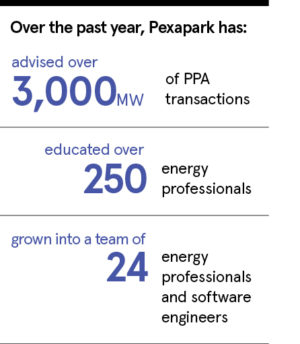The market for renewable energy is undergoing significant change as government subsidies and support schemes are scaled back, in the context of budgetary pressure and a surge in new installations. As a result, new ways of trading green energy are taking over.
Investors in renewable energy markets have, in recent years, become much more exposed to open market forces; the lack of government support means investors no longer have guarantees and fixed prices they took for granted.
These changes have introduced many new challenges for producers of wind and solar energy, and the market can easily appear opaque to buyers and sellers, which need new ways to understand production, market forces and pricing confidently.
“Subsidies have been fuelling renewables for a long time, making them low risk,” explains Michael Waldner, chief executive and co-founder of Pexapark, which provides consultancy and software to guide energy producers, investors and buyers.
“Today, if you invest in a renewables project you don’t have the government price guarantee and you have to find the best deal in the market.”
For investors, producers and consumers, introducing real transparency based on deep market understanding is the only way for successful deals to be negotiated
Buyers and sellers of renewable energy now rely on power purchase agreements (PPAs) to set key terms between them over the next ten to fifteen years and getting these right requires an in-depth market understanding.
“Everything can be negotiated from the volume and the price, to the credit and the regulatory terms,” Mr Waldner explains. “Parties are seeking expertise in how to go about contract structuring, how to go about pricing and where to find buyers.”
 The need for a clear market view is ever-growing; numerous producers are quickly starting up, as technology slashes costs. Meanwhile, many large corporates, including the likes of Facebook, Google and Amazon, increasingly satisfy their high appetite for green electricity by purchasing directly from those producers, rather than traditional utilities. Some 5.4 gigawatts of energy was bought this way in 2017 alone, a 25 per cent increase on the previous year, according to Bloomberg New Energy Finance.
The need for a clear market view is ever-growing; numerous producers are quickly starting up, as technology slashes costs. Meanwhile, many large corporates, including the likes of Facebook, Google and Amazon, increasingly satisfy their high appetite for green electricity by purchasing directly from those producers, rather than traditional utilities. Some 5.4 gigawatts of energy was bought this way in 2017 alone, a 25 per cent increase on the previous year, according to Bloomberg New Energy Finance.
Pexapark advises producers of renewable energy that need guidance and support as they take their projects from inception through to the point of selling megawatt hours on the open market. Using advanced quantitative models and industry expertise, it simplifies pricing and risk assessment. It also has an academy to tutor market participants on structuring and pricing PPAs, and reports on long-term pricing and opportunities. Equally, it helps companies source renewable energy and make the right arrangements.
The company has created its own cloud software PexaMonitor, which helps sellers analyse market risk exposure and costs in detail. Its other platform PexaConnect brings together buyers and sellers to facilitate trades. Mr Waldner explains: “Sellers can see all the interest on the buyer side, while corporations consuming the power can request a quote or request a proposal for specific packages of renewable energy.”
Since its inception in August 2017, Pexapark’s services and its software platforms have quickly gained traction in a market clearly in need of added transparency. Having grown its team to 24, half of whom are renewable energy market experts and the other half IT specialists, the Swiss firm is looking to expand further its workforce and grow beyond Europe.
Renewable energy markets continue to see fast-changing dealmaking, and risk and price assessment, and there will be significant transition in the coming years as participants get to grips with new opportunities. For investors, producers and consumers, introducing real transparency based on deep market understanding is the only way for successful deals to be negotiated.
To find out how to gain transparency in the open market for renewables please visit pexapark.com
